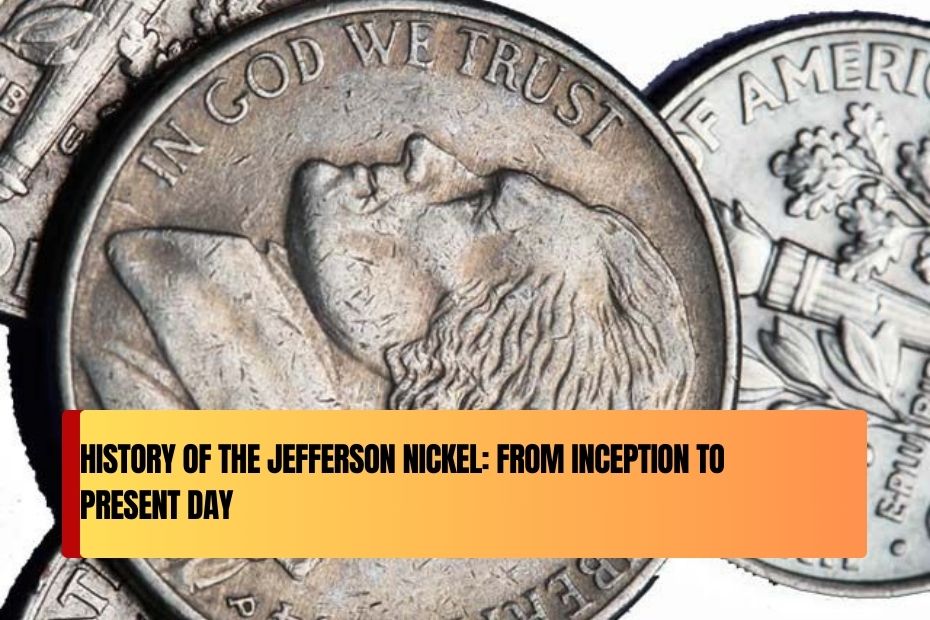The Jefferson Nickel is a well-known coin in the United States, often found in pockets, coin collections, and even in old change jars. It has an interesting history that stretches back over 80 years. Since its creation in 1938, the Jefferson Nickel has undergone many changes, from design updates to its role in the U.S. economy. This article will take you on a journey through the history of the Jefferson Nickel, from its inception to its place in today’s world.
The Inception of the Jefferson Nickel
The Jefferson Nickel was introduced in 1938, replacing the earlier Buffalo Nickel, which had been in circulation since 1913. The new nickel was designed by artist Felix Schlag, and it was meant to feature a portrait of President Thomas Jefferson, the third president of the United States. This design was chosen to honor Jefferson’s contribution to the founding of the nation, especially his role in drafting the Declaration of Independence and his leadership in the Louisiana Purchase.
Key Features of the 1938 Design:
- Obverse (Front): A portrait of Thomas Jefferson.
- Reverse (Back): A depiction of Jefferson’s home, Monticello, located in Virginia.
The 1938 design of the Jefferson Nickel was widely accepted and remained largely unchanged for many years.
Design Changes and Updates
Throughout the years, the Jefferson Nickel underwent several changes in design. These updates reflected both historical events and the evolving art styles of the U.S. Mint. One of the biggest changes happened in 2004, when the U.S. Mint introduced new designs to celebrate the bicentennial of the Lewis and Clark Expedition. This was the first time in history that the reverse design of the Jefferson Nickel was altered.
Significant Design Changes:
- 2004-2005: New reverse design featuring a rendition of the Westward Journey, commemorating the Lewis and Clark Expedition.
- 2006: Return to the original Monticello reverse, but with a new, updated look.
These changes reflected the U.S. Mint’s desire to honor historical events and figures while keeping the coin relevant to modern collectors.
Composition of the Jefferson Nickel
The Jefferson Nickel’s metal composition has changed over time. Initially, the coin was made of 75% copper and 25% nickel. However, due to the rising cost of metal during World War II, the composition of the Jefferson Nickel was altered to include silver. This change occurred between 1942 and 1945, during the war effort. After the war, the coin returned to its original composition of copper and nickel.
Composition Changes Over Time:
- 1938-1941: 75% copper, 25% nickel.
- 1942-1945: 56% copper, 35% silver, 9% manganese (due to wartime shortages).
- 1946-present: 75% copper, 25% nickel.
These changes not only affected the coin’s appearance but also its weight and the way it interacted with other metals in circulation.
The Role of the Jefferson Nickel in U.S. Currency
The Jefferson Nickel has played an important role in U.S. currency, both in terms of practical use and its cultural impact. It is one of the most commonly used coins in everyday transactions, alongside the penny, dime, and quarter. The coin has also gained significance in the world of coin collecting, with rare editions and design changes being highly sought after.
Over the years, the nickel has remained a symbol of American history and pride, representing the country’s values and the achievements of figures like Thomas Jefferson.
Jefferson Nickel Table: Key Facts and Changes
| Year | Design Change | Key Feature |
|---|---|---|
| 1938 | First issued | Portrait of Thomas Jefferson on the obverse, Monticello on the reverse. |
| 1942-1945 | Wartime Composition | 56% copper, 35% silver, 9% manganese due to war shortages. |
| 2004-2005 | Bicentennial Design | Reverse features the Westward Journey, celebrating the Lewis and Clark Expedition. |
| 2006 | Return to Monticello | Reverse returns to Monticello, with a new, updated design. |
| 2010-present | Minor Updates | More minor updates, including changes in metal alloy. |
Conclusion
The Jefferson Nickel has come a long way since it was first introduced in 1938. From its initial design featuring Thomas Jefferson and Monticello, to the various changes and updates over the years, this coin has reflected both the history and the evolving nature of the United States. Whether you are a coin collector, history buff, or simply someone interested in the history of U.S. currency, the Jefferson Nickel is a fascinating symbol of American culture.
Although its design has been updated, the Jefferson Nickel remains an important part of American coinage. It has withstood the test of time and continues to be a beloved coin in circulation today.
FAQ’s
1. Why was the Jefferson Nickel introduced?
The Jefferson Nickel replaced the Buffalo Nickel in 1938 and was designed to honor Thomas Jefferson, the third president of the United States.
2. What was the original design of the Jefferson Nickel?
The original design featured a portrait of Thomas Jefferson on the obverse and an image of his home, Monticello, on the reverse.
3. Why did the composition of the Jefferson Nickel change during World War II?
Due to a shortage of metals caused by World War II, the Jefferson Nickel was made with a mix of copper, silver, and manganese from 1942 to 1945.
4. When was the Monticello design used on the Jefferson Nickel?
The Monticello design appeared on the reverse of the Jefferson Nickel from 1938 until 2004, when it was briefly replaced by a new design to celebrate the Lewis and Clark Expedition.

